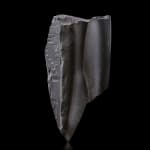Egyptian
Provenance
Dr. Bruce Ralston (d. 1998) Collection, New York, acquired prior to September 1979, thence by descentLiterature
This fragment comes from a statue of a standing Ptolemaic Queen, maybe Arsinoe II, holding the 'lily sceptre'. For similar examples see A. Donadoni et al., Il Museo Egizio di Torino, Novara, 1993, p. 207, now in the collection of the Egyptian Museum in Turin, inv. no.5466 and S. Albersmeier, Untersuchungen Frauenstatuen Ptolemäischen Ägypten, Mainz, 2002, pp. 29-32, pl. 75, for statues in the Egyptian Museum, Cairo, inv. no. JE39406, and the National Archaeological Museum, Florence, inv. no. 6315.
This statue represents the idealised, modest yet desirable depiction of the female form refined in the Late Dynastic to early Ptolemaic period. The fitting dress enhances her figure as much as it covers, with the shape of her slightly rounded stomach as well as the dip of her navel visible beneath the drapery. On the reverse, careful attention has been made to show the curve of her buttocks juxtaposed with the straight lines of the back pillar and her smoothly rendered arm.
The surviving title of ‘[...] ç [...]' is a title commonly found on statuary of Ptolemaic queens. For example Arsinoe II’s titles on the Mendes Stele features, ‘sweet of love’. For further discussion of such titulature see L. Troy, 'Patterns of Queenship in Ancient Egyptian Myth and History', Boreas 14, Uppsala, 1986, Register B, no. A 2/1; B 1/11; B 3/10; B 4/11; D 2/1. See also, M. Gitton, ‘Variation sur le thème des titulatures de reines’, BIFAO 78, 1978, pp. 389-403.
Flowers are among the oldest attributes in Egyptian art and in all periods one can find representations of both women and men with flowers, bouquets or wreaths in their hand. In the Ptolemaic period fronds are sometimes held to the chest as in this example and are the remit of royalty and god’s wives. Bothmer described it as ‘a scepter as much as a symbol of femininity’ ESLP 1. For further discussion see J. Dittmar, ‘Flowers and Bouquets of Flowers as Offerings in Ancient Egypt’, MÄS 43, 1986, p. 132ff.
This is a carved fragment of elegant form and in a fine quality greywacke which ‘was considered to be one of the most prestigious materials used during the course of the Egyptian Late Period.
With thanks to Ollivier Perdu for his invaluable assistance.



